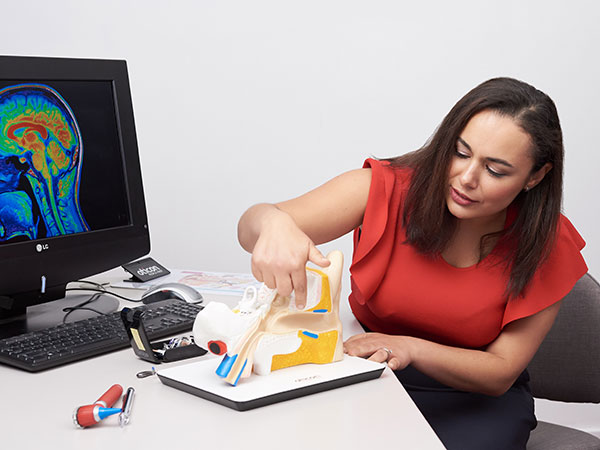Central auditory processing disorder assessment
A child with central auditory processing disorder (CAPD) hears well but their brain does not correctly interpret the sounds. That can lead to difficulties at school.
Active Audiology’s testing can detect CAPD.
How should hearing
interact with the brain?
Hearing is a complex process. Sound waves enter your ear and cause your eardrum to vibrate. Those vibrations cause the fluid in your cochlea to ripple, which ultimately creates an electric signal. Your auditory nerve carries that electrical signal to your brain, which converts it to a sound you can recognise and understand.
The central auditory nervous system (CANS) plays a key role in this process. Its job is to process signals that help you:
- recognise and localise sounds
- filter sounds and pay attention to the important ones
- recognise patterns
- attach meaning to sounds.
Hearing
Ears receive sounds and send them to the brain
Understanding
Brain accurately translates those messages into meaning
What happens in CAPD?
In CAPD, something interrupts this process. The parts of the brain that process auditory information do not connect properly with other brain regions that perceive and understand sounds. The message gets scrambled and mis-translated.
About 2-5% of children have CAPD. Because their ears and their brain are not working well together, a child with CAPD can hear sounds but not process their meaning.

What are the symptoms of CAPD?
There’s a big difference between hearing and listening. People with CAPD have normal hearing yet struggle with learning, listening and communication.
CAPD = a problem with the way that hearing and the brain
work together to understand sound.
Difficulty recognising and interpreting sounds
Unusually sensitive to sounds
Hard to work out:
- what a sound is
- where the sound came from
- when the sound happened
Difficuly hearing when there’s background noise or distractions
Difficulty remembering or following verbal instructions
Easily distracted
Writing, reading and spelling problems
Difficulty telling the difference between similar sounding speech sounds such as “ba” and “ga” or “f” and “th”.
Mishearing or needing someone to repeat their words
What causes CAPD?
There’s still a great deal we don’t know about the causes of CAPD, which can be frustrating for parents and educators.
Recurrent ear infections may play a role for some children as may delayed development of the CANS. There is still much to learn here.
How do you treat CAPD?
Treating CAPD may involve:
- Audiology strategies – like using a personal remote microphone or sound field amplification system to hear more clearly in noisy situations
- Speech pathology – to improve language skills
- Psychological support – such as an educational psychologist to support schooling
- Liaison with school – strategies your child’s teacher can use to support learning.
CAPD assessments at Active Audiology?
Your first appointment will involve a thorough review of your child’s history followed by a standard hearing test.
If the hearing test shows that your child can hear well but their symptoms suggest CAPD, we will book a full CAPD assessment.
This is a separate appointment. Testing can be tiring for your child and it is important that they are fresh for their CAPD assessment.
Our full CAPD assessment evaluates several different aspects of auditory processing, focussing on areas that will affect learning and lead to problems hearing a noisy classroom.
CAPD assessment
Based on the recommendations of the National Acoustic Laboratories
and the American Speech-Hearing Association.
The Listening in Spatialised Noise Sentence Test (LiSN-S)
Measures your child’s ability to use spatial information to help them understand speech in a noisy environment.
20 minutes
Dichotic Digits Test
Checks how well your child can integrate information coming into both ears at the same time. This is very important for listening in the classroom.
10 minutes
Random Gap Detection Test
Focuses on ability to separate a series of sounds. A child with poor results will probably have difficulty with speech discrimination.
15 minutes
Pitch Pattern Perception Test
Tests ability to distinguish sounds of different pitches, which relates to the ability to understand verbal instructions and follow conversation.
15 minutes
These tests are all performed using headphones in a sound-treated room.
Once the testing is complete, we will explain our findings to you and explore the next steps together.
How can Active Audiology help?
Active Audiology is a leading audiology clinic with several locations around Melbourne’s suburbs. Our highly trained audiologists play a key role in assessing and diagnosing CAPD and in supporting children and families after diagnosis.
If you suspect that your child may be showing signs of CAPD, we encourage you to come and see us.

